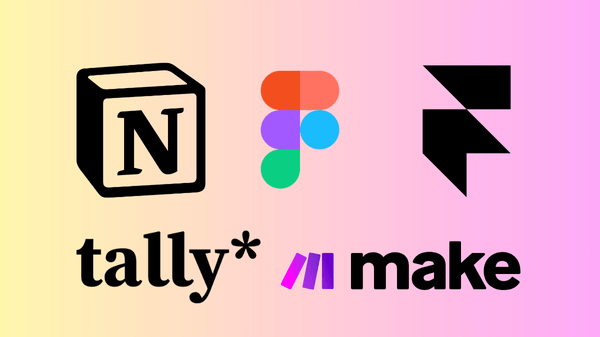

My Favorite Web Design Tools for 2024
Aug 20, 2024
After more than a decade in the web design industry, I’ve seen tools come and go. Some have stuck around because they genuinely make a difference, while others have faded into obscurity. As of 2024, the landscape of web design has evolved dramatically, with tools that not only simplify the creative process but also integrate seamlessly with each other. Today, I want to share with you my top picks for web design tools this year: Figma, Framer, Notion, Tally, and Make. These tools have revolutionized the way I work, and I’m confident they’ll do the same for you.
Figma: The Power of Collaborative Design
Link to Figma: figma.com
Figma has been my go-to design tool for years, and it continues to impress in 2024. It’s an online design platform that excels in collaboration, allowing teams to create, share, and iterate on designs in real-time. What I love about Figma is its simplicity and versatility. Whether you’re working solo or as part of a team, Figma centralizes the entire design process, from wireframes to the final mockups.
The real game-changer with Figma is how it fosters collaboration. As a designer, being able to work closely with clients and colleagues is essential. With Figma, you can share interactive prototype links, making it easy to get real-time feedback. No more sending heavy files or juggling multiple versions of the same document.
Why Figma in 2024?
Real-time collaboration: Design and edit with others simultaneously, no matter where they are.
Interactive prototypes: Test and visualize your concepts before moving to development.
Rich community: Tap into shared resources like templates, plugins, and more from other designers.
Framer: From Design to Website in Just a Few Clicks
Link to Framer: framer.com
Framer has transformed how I approach website creation. It’s more than just a design tool; it’s a platform that lets you turn your designs directly into functional websites without writing a single line of code. For someone who values both aesthetics and performance, Framer is a dream come true.
What sets Framer apart is its seamless integration of design and development. The interface is intuitive, and the design tools are robust, allowing you to create beautiful, high-performing websites in no time. And the best part? You don’t need to be a coding expert to make it happen.
Why Framer in 2024?
Fast website creation: Go from concept to live site without needing to code.
Design-first approach: A tool built for designers who want complete control over how their sites look.
Performance: Build fast, responsive websites that are optimized for all devices.
Notion: The All-in-One Tool for Organizing Your Projects
Link to Notion: notion.so
Notion has become an indispensable part of my daily routine, from project management to documentation and planning. This all-in-one tool lets you centralize everything you need to keep a web design project running smoothly. Whether it’s creating to-do lists, storing resources, or documenting processes, Notion’s flexibility is unmatched.
As a designer, I use Notion for everything: organizing ideas, tracking project progress, and collaborating with clients and colleagues. Its modular structure allows you to create databases, nested pages, and customizable templates that fit your specific needs. It’s the perfect tool for keeping all your projects tidy and accessible.
Why Notion in 2024?
Flexibility: Customize Notion to fit your exact needs, whether for project management or documentation.
Centralized information: Keep all your resources, notes, and tasks in one place.
Collaboration: Easily share pages with your team or clients for complete transparency.
Tally: Simplifying Form Creation
Link to Tally: tally.so
Creating online forms has never been easier than with Tally. Whether you need a contact form, a survey, or an event registration, Tally lets you build it in minutes. What I appreciate about Tally is its minimalist interface and lack of unnecessary complications. Unlike other form builders, Tally doesn’t require any technical skills, yet it offers plenty of customization.
One of Tally’s biggest strengths is that it’s free for most essential features. You can start creating professional forms without spending a dime, making it perfect for small businesses or independent entrepreneurs. Plus, Tally integrates effortlessly with other tools like Notion, making data management even more streamlined.
Why Tally in 2024?
Ease of use: Build forms in just a few clicks without any hassle.
Cost-effective: Access powerful features without paying a premium.
Smooth integration: Connect Tally with other tools like Notion or Google Sheets to manage collected data.
Make: Automation at Your Fingertips
Link to Make: make.com
Make is the automation tool that helps me connect all the dots in the digital puzzle. Whether it’s automating repetitive tasks, syncing data between platforms, or creating complex workflows, Make allows you to do it all without writing a single line of code.
What’s fantastic about Make is its ability to connect virtually any online service. You can automate tasks between your favorite tools (like Figma, Notion, Tally, and more) using a simple visual interface. This means more time to focus on creativity and less time spent managing repetitive processes.
Why Make in 2024?
No-code automation: Create automated workflows to simplify your work.
Powerful integrations: Easily connect different tools and online services.
Time-saving: Automate repetitive tasks and focus on what truly matters.
Conclusion: Tools That Make a Difference
Web design tools have come a long way, and in 2024, they’re more powerful and accessible than ever. Figma, Framer, Notion, Tally, and Make have become staples in my daily workflow, enabling me to create exceptional designs while boosting efficiency.
Whether you’re a seasoned designer or a budding entrepreneur, these tools will help you bring your ideas to life while simplifying the entire process from start to finish.
Each tool brings something unique to the table, and together, they form a harmonious ecosystem that makes web design more enjoyable and productive.
So whether you’re looking to collaborate more effectively, build websites without coding, organize your projects, or automate tasks, these tools are here to make your life easier.
